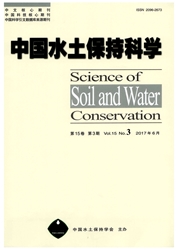

 中文摘要:
中文摘要:
为研究坡地物质迁移的重要过程,通过室内人工降雨模拟试验,研究不同透水状况坡地土壤侵蚀和养分流失的过程与机制。研究结果表明:不透水坡地的初始产流时间比半透水和完全透水坡地提前5-7min,且土壤侵蚀总量大于其余两者土壤侵蚀量之和;在二次降雨条件下,不透水坡地的土壤侵蚀剧烈,土壤侵蚀量大于其他2种状况之和的5倍;在首次降雨过程中3种不同透水状况的径流养分浓度变化表现一致,仅在降雨75min后开始呈现差异;二次降雨过程中径流养分浓度存在显著差异。因此,存在不透水底层或人渗速率低的犁底层坡地,具有潜在的严重土壤侵蚀与磷钾流失趋势,尤其在初始土壤含水量较高的情况下。为合理配置坡地水土保持管理措施和控制养分流失提供参考。
 英文摘要:
英文摘要:
To study mass transport from slope land, the process and mechanism of soil erosion and nutrient loss on the slope land under different drainage conditions were investigated by simulating rainfall. Results had indicated that, runoff from the impervious-base soil boxes was generated 5 - 7 min earlier than those from slurry and impervious-base boxes. The total amount of soil erosion from the impervious-base was much more than the sum of those of slurry and impervious-base. Especially, soil erosion of the impervious-base was extremely intensive during the second simulating rainfall, and the amount of soil loss was much 5 times than the sum. There was no significant discrepancy for chemical concentration in runoff from the three kinds of base boxes during the initial rainfall. However, during the second rainfall, there was notable discrepancy for chemical concentration in runoff from the different conditions. Therefore, the existing impervious base and low-infihrate rate ploughed-base slope lands are the potential hazards of soil erosion and phosphorus and potassium loss, especially under initial soil water high content. The work may provide some useful information for allocating water and soil conservation management measurements and preventing nutrient loss on the slope land.
 同期刊论文项目
同期刊论文项目
 同项目期刊论文
同项目期刊论文
 期刊信息
期刊信息
